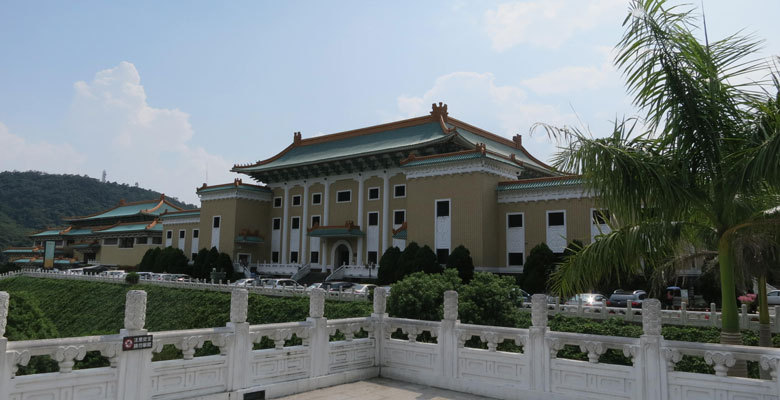
The National Palace Museum (NPM) is considered to be a national treasure in Taiwan, and is on just about every top list of things to see in Taiwan. And there is no doubt of the importance of the hundreds of thousands of artefacts, chronicling thousands of years of Chinese history.
The bulk of the artefacts were brought to Taiwan by the Nationalists—led by Chiang Kai-shek—in 1949, and whether or not this was because of fears that they would be destroyed by the communists is controversial. However, the NPM has done an excellent job of preserving the collection, and it’s difficult to believe so many would have survived the turbulent times without the move.
The museum is located in the Shilin district of Taipei (see it on a map), and the museum complex is quite striking, designed perhaps to look like the palace its name implies. There are gardens surrounding the museum complex and a fairly new restaurant run by Silks, but otherwise there is not much else to see on foot in the immediate area.
You are not allowed to take backpacks into the museum, and you are not allowed to take photos or video. You are therefore required to check in any bags you have, which is free at the room on the left of the main door (somewhat surprisingly it is outdoors). Although there are attendants, I am never comfortable leaving valuable items like laptops in these kind of places. The only option, however, is not to bring valuables with you.
Audio sets are available in a variety of languages to the left of the entrance into the museum. The exhibits are all well displayed, and most have English descriptions if you do not have a headset.
The main exhibition building consists of three floors with roughly eight rooms per floor of exhibits; a tea shop occupies the fourth floor, so it is not a huge space overall. It is probably best to start with the orientation room on the first floor for a brief guide to the history of China, and then explore the rest of the first floor. I particularly enjoy the rare books and documents on the first floor and the special exhibits are usually interesting (check the website for the latest news).
On the second floor the focus is on painting, calligraphy and ceramics. Among the many scrolls here is one in particular dating back to 721 A.D. written by the Emperor Xuanzong which is an “ode on pied wagtails”. It is in astonishing condition and I found it quite captivating. Even if this is not your thing, I expect there is something in the museum that will be.
Ceramics is the other big feature of the second floor, including porcelain from the 11th and 12th centuries called “ding ware”. However, you do have to be really interested as one white bowl does tend to look the same as another by the fourth display case even though they are beautifully crafted and displayed. As I said, it depends on your level of interest.
Perhaps the most renowned exhibit in the museum, the jadeite cabbage, is displayed on the third floor; unless of course it is on a trip. Also on the third floor are the “antiquities”, which along with the jade seemed to be the most popular sections. Beautiful although they are, it can be a struggle to see them and this is perhaps my biggest complaint with the museum.
I know that this is the most popular museum in Taiwan, and I know it is going to be busy. Very busy in fact. However, I couldn’t help but smile at the “please be quiet” signs with some irony. It’s not the individual visitors but the guided tours that are the problem. And it’s not as if these tours are reasonably spaced in time. I chose what I thought would be a quiet period (Thursday lunch) to visit, but there was still a constant stream of guided tours, making it both noisy and difficult to get close to the exhibits on the third floor.
Having said that, it is possible to find a quiet area with a little patience. Did I mention the scrolls?
As discussed above, the museum complex is fairly isolated, so for food options you either have Silks Palace, the Sanxitang teahouse on the fourth floor of the exhibition building—serving light food such as dim sum and noodles, and a couple of cafés serving sandwiches on the first floor.
The best way to get there is probably on the MRT to the Dazhi or Shilin station, and then either take a bus or taxi to the museum. For full details check the museum’s website. Entrance costs NT$250 for adults and NT$150 for children, and the opening hours are 8:30am to 6:30pm daily. Guided tours are available, although you will need to book these at least three days in advance.
As the NPM is so revered, it seems churlish to question its role as the most important place to visit in Taiwan. However, the number and volume of the tour groups were a concern for me, and I have heard these concerns from others.
Another question is the relevance of the NPM over other museums that are perhaps more pertinent to Taiwan, such as the National Taiwan Museum, National Museum of History, and the Shihsanhang Museum of Archaeology to name just a few. In my opinion, and it is only my opinion, there are many better ways to learn about the region in general and Taiwan in particular.
